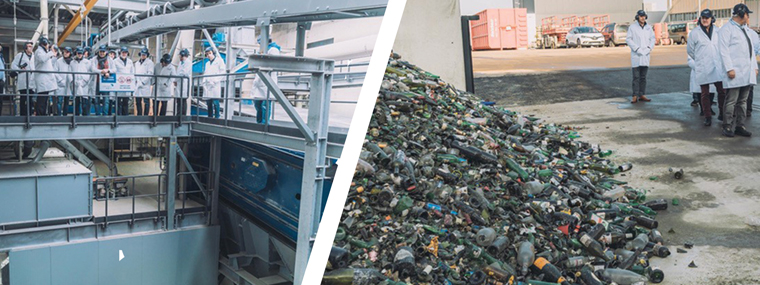
Beer and Wine, Recycling, and Drinking-Water Quality Pool Water
By Alvaro G. Mendoza / Published April 2020

What does drinking beer and wine have to do with drinking-grade water quality? A lot, but in order to review this recent technological advance, we need to venture into the past.
In the 1930s, the swimming pool industry first used large pressurized metal tanks filled with a special grade of silica sand as the premier form of filtration. These filters replaced earlier technologies dating back to the 1890s. The filters were between four to ten feet in diameter and used fairly rudimentary internals, and the water moved quite slowly through them so as to not disturb the thin layer of sand filter media that lay on top of several layers of a gravel subbase. These became known as “rapid sand” filters, and many pump rooms were built around these sometimes-colossal vessels.
By the mid-1980s, several manufacturers began to make smaller cylindrical metal vessels that fit through a standard door, could be placed side-by-side or stacked, and contained all sand. This allowed the water to be moved quicker through the filters, essentially reducing both the filter size and cost. These filters were known as “hi-rate” filters, and manufacturers were able to tweak the design and the filter media to achieve EPA-approved drinking water certification.
Today, these same vessels are mostly made of high-strength fiberglass in order to prevent corrosion, can be semi- or fully automatic, and come in a variety of sizes to provide maximum flexibility in equipment room design.
What does this have to do with drinking beer and wine? In contrast to all the developments in pool filters over the past 100-plus years, the media inside the filters—what actually does the filtering—has changed very little. It is still specially graded silica sand.
The term “sand” can be misleading, as plain sand does not work well in filters. It’s just not sharp enough since it has been rounded from millions of years of erosion, and it is not uniform enough. The successful silica sand media comes from certain mines, is jagged (when seen under a microscope), and is specially graded so that the media is very uniform in size, making a tight weave to filter out finer particles. Some innovative commercial pool specialists began using garnet media (like your grandmother used in her broach) instead of sand, in order to mimic the drinking water-grade filters that achieved EPA certification.
However, a recent technological advance has infused new excitement into swimming pool filtration. It’s good news for the environment and good news for swimming pool patrons as well.
Beer, wine, and pool filtration
It starts with beer and wine bottles, lots of them. Once consumed they end up as a pile of glass sometimes mixed with labels, bottle caps, and cigarette and napkin remnants. Then, off they go to the recycling center.
But, not just any glass will do. It turns out that brown and green glass give the filter media special attributes, especially if 98 percent brown and green glass is used, but how do you sort out the good from the bad glass?
A new manufacturing technology cleans, sorts, and mills the glass to prevent shards that could cut operators and pool patrons alike and provides the precise uniformity that is so critical for proper filtration.
New manufacturing plants in Scotland and Switzerland are leading the industry in this field. Here the piles of recycled glass go through a multiple-step automated process that separates the good from the bad glass and culminates in clean, perfectly graded, shard-free glass media that is bagged, palletized, and ready to transform drinking water, aquaculture, and yes, swimming pools.
In the solar-powered plants in Switzerland, this process includes air blowers, centrifuge, super-magnets, a mile of conveyer belts, and a completely automated system that runs the entire operation. It’s pretty impressive to see recycled “glass garbage” enter one end of the plant and come out the other end as clean, graded, and bagged drinking water-grade filter media. A special part of this process is called “activation.”
Activation Process
It turns out that besides protecting beer and wine contents from unwanted aging, brown and green glass contain special metal oxides that allow it to be super-charged as filter media. A unique three-step manufacturing process gives the glass a chemically aided thermal charge that provides two major benefits: self-sterilizing properties and finer filtration.
Self-sterilizing properties: Typical filter media can accumulate organics and bio-film, especially if the filter itself doesn’t have vibrant backwash characteristics. The biofilm will form a protective coating around the bacteria and other undesirables and will develop into a breeding ground for pathogens, such as legionella and pseudomonas. When swimmers add sweat and urine in the pool, the bacteria in the filter will react with the chlorine to form chloramines that will provide an unpleasant odor, while also contributing to skin, eye, and lung irritation. These will also cause a drag on the chlorine in the pool, increasing consumption and raising pool operating costs.
The activation process provides self-sterilizing properties to prevent the formation of biofilm and thus helps prevent fouling and resultant chloramines and irritation.
Finer filtration: Activation also gives the media a permanent charge that helps clump and attract finer particles so that they can be caught in the filter. That helps enhance the clarity of the pool water.
How difficult is this type of conversion?
One of the best features of activated filter media is that it is quite easy to implement in most new and retrofit filter systems. You simply remove any existing media via a vacuum or septic truck, depending on the size of the filter, and install the new glass media, which is easily handled thanks to the packaging in 55-pound bags. Most installations have been completed within a working day, and the conversion is much simpler and less costly than earlier drinking-water grade garnet conversion.
What is the end effect?
Besides the reduction of irritants and bacteria, a properly designed and executed activated glass filter media conversion will accomplish several important things:
It will save water: Typically, the backwash cycle, where the operator reverses the water flow through the filters to release captured solids, is cut in half. So, a five-minute cycle becomes two and a half minutes, and a three-minute backwash cycle can be normally competed in just one and a half minutes. Significant water savings are great, but add in the cost of replacement heat and chemicals, and the savings grow exponentially.
It will filter finer: The combination of the media sharpness and the activation process should combine to filter more particles than standard sand media, making the water sparkle. That was the pool-side observation during several recent condominium conversions.
It will last longer: Typical sand filters require periodic media changes due to fouling or loss of media angularity or sharpness. The structure and self-sterilizing properties of the glass media means it should last the life of the filters in most installations, or definitely longer than any other filter media solution. Media change-outs are messy and expensive, so avoiding them altogether is a big advancement for pool owners and operators.
Conclusion
Sand filters have traditionally offered condominiums excellent water quality at a fraction of the labor costs of temporary media or cartridge filter systems.
New technologies to convert standard silica sand media to certain brands of activated glass media from recycled glass that can achieve drinking-water grade filtration is good for the recycling business, and it’s also good news for the swimming pool industry. Patrons can swim in better water quality with an improved irritant-free and odor-free environment, and owners can save time, water, and money in their pool operation. What better reason to drink more beer and wine?
Alvaro G. Mendoza
President, Commercial Energy Specialists (CES)
Alvaro Mendoza is President of Commercial Energy Specialists (CES). CES helps you take total control of your pool operation for affordable crystal-clear water with guaranteed results. Programs are custom tailored to each site and to each water treatment application. The programs consist of a combination of chemical treatment and filtration hardware, software, training, service, supplies, remote monitoring, alert notification, and on-going support. Every program includes 24 hr. per day direct automatic control of water chemistry, and the establishment of a comprehensive CES water quality treatment program on your site. For more information, call (561) 744-1557 or visit www.ceswaterquality.com.




